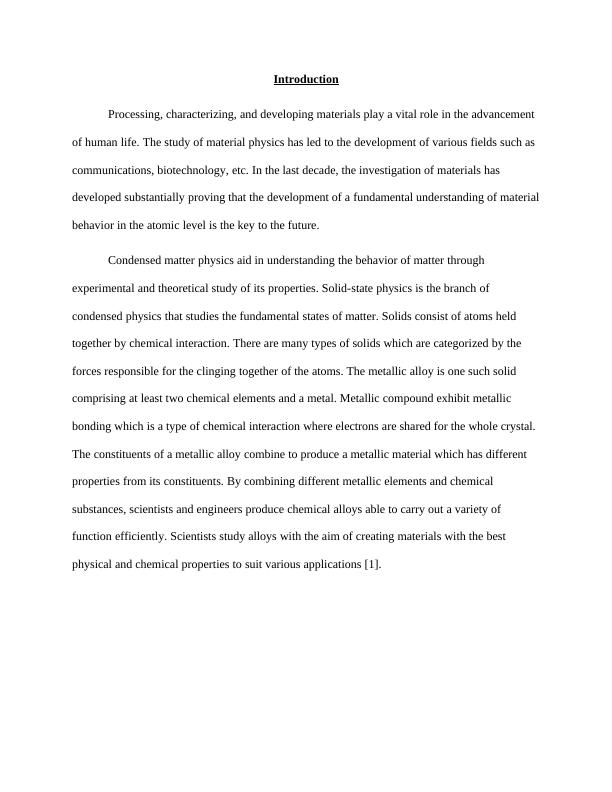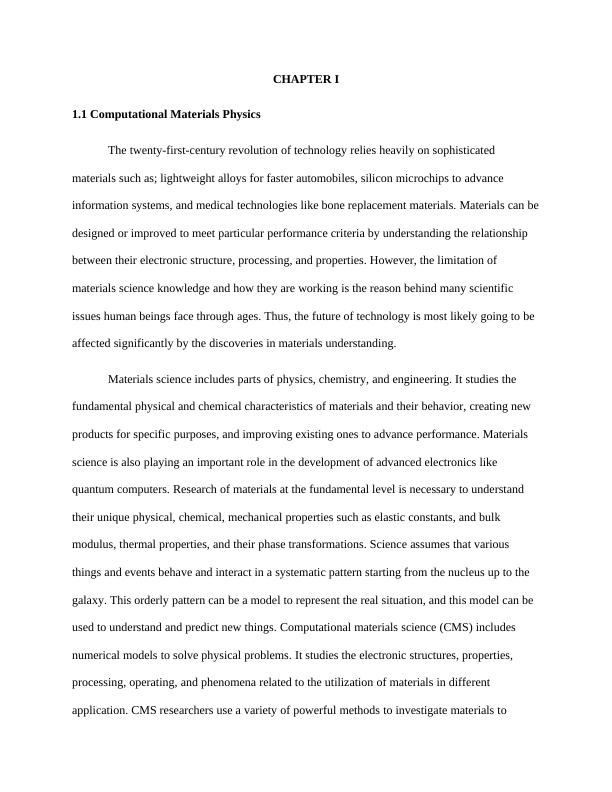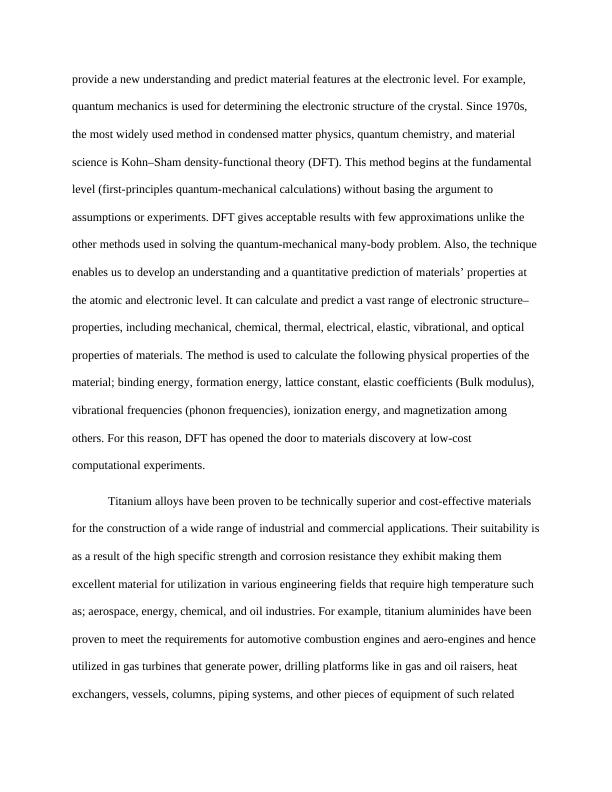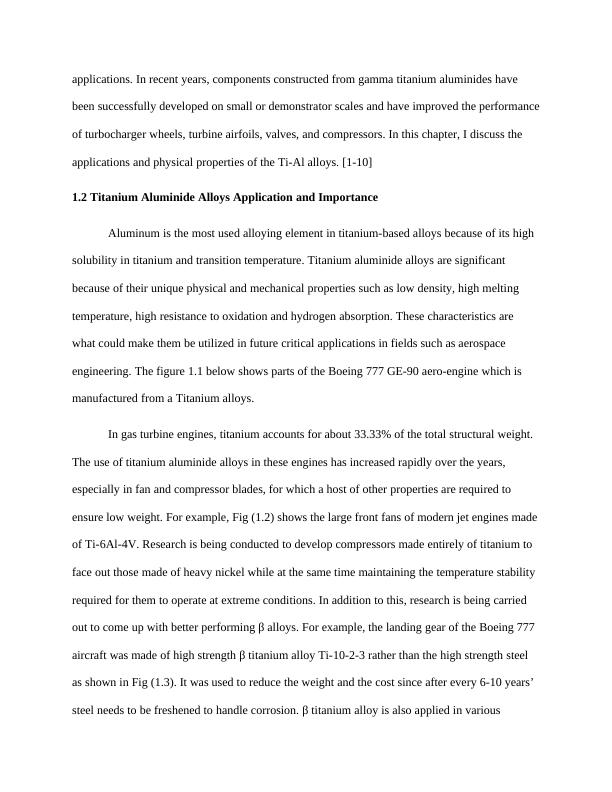Ask a question from expert
Processing, characterizing, and developing materials PDF
11 Pages3321 Words179 Views
Added on 2021-10-28
Processing, characterizing, and developing materials PDF
Added on 2021-10-28
BookmarkShareRelated Documents
Introduction
Processing, characterizing, and developing materials play a vital role in the advancement
of human life. The study of material physics has led to the development of various fields such as
communications, biotechnology, etc. In the last decade, the investigation of materials has
developed substantially proving that the development of a fundamental understanding of material
behavior in the atomic level is the key to the future.
Condensed matter physics aid in understanding the behavior of matter through
experimental and theoretical study of its properties. Solid-state physics is the branch of
condensed physics that studies the fundamental states of matter. Solids consist of atoms held
together by chemical interaction. There are many types of solids which are categorized by the
forces responsible for the clinging together of the atoms. The metallic alloy is one such solid
comprising at least two chemical elements and a metal. Metallic compound exhibit metallic
bonding which is a type of chemical interaction where electrons are shared for the whole crystal.
The constituents of a metallic alloy combine to produce a metallic material which has different
properties from its constituents. By combining different metallic elements and chemical
substances, scientists and engineers produce chemical alloys able to carry out a variety of
function efficiently. Scientists study alloys with the aim of creating materials with the best
physical and chemical properties to suit various applications [1].
Processing, characterizing, and developing materials play a vital role in the advancement
of human life. The study of material physics has led to the development of various fields such as
communications, biotechnology, etc. In the last decade, the investigation of materials has
developed substantially proving that the development of a fundamental understanding of material
behavior in the atomic level is the key to the future.
Condensed matter physics aid in understanding the behavior of matter through
experimental and theoretical study of its properties. Solid-state physics is the branch of
condensed physics that studies the fundamental states of matter. Solids consist of atoms held
together by chemical interaction. There are many types of solids which are categorized by the
forces responsible for the clinging together of the atoms. The metallic alloy is one such solid
comprising at least two chemical elements and a metal. Metallic compound exhibit metallic
bonding which is a type of chemical interaction where electrons are shared for the whole crystal.
The constituents of a metallic alloy combine to produce a metallic material which has different
properties from its constituents. By combining different metallic elements and chemical
substances, scientists and engineers produce chemical alloys able to carry out a variety of
function efficiently. Scientists study alloys with the aim of creating materials with the best
physical and chemical properties to suit various applications [1].

CHAPTER I
1.1 Computational Materials Physics
The twenty-first-century revolution of technology relies heavily on sophisticated
materials such as; lightweight alloys for faster automobiles, silicon microchips to advance
information systems, and medical technologies like bone replacement materials. Materials can be
designed or improved to meet particular performance criteria by understanding the relationship
between their electronic structure, processing, and properties. However, the limitation of
materials science knowledge and how they are working is the reason behind many scientific
issues human beings face through ages. Thus, the future of technology is most likely going to be
affected significantly by the discoveries in materials understanding.
Materials science includes parts of physics, chemistry, and engineering. It studies the
fundamental physical and chemical characteristics of materials and their behavior, creating new
products for specific purposes, and improving existing ones to advance performance. Materials
science is also playing an important role in the development of advanced electronics like
quantum computers. Research of materials at the fundamental level is necessary to understand
their unique physical, chemical, mechanical properties such as elastic constants, and bulk
modulus, thermal properties, and their phase transformations. Science assumes that various
things and events behave and interact in a systematic pattern starting from the nucleus up to the
galaxy. This orderly pattern can be a model to represent the real situation, and this model can be
used to understand and predict new things. Computational materials science (CMS) includes
numerical models to solve physical problems. It studies the electronic structures, properties,
processing, operating, and phenomena related to the utilization of materials in different
application. CMS researchers use a variety of powerful methods to investigate materials to
1.1 Computational Materials Physics
The twenty-first-century revolution of technology relies heavily on sophisticated
materials such as; lightweight alloys for faster automobiles, silicon microchips to advance
information systems, and medical technologies like bone replacement materials. Materials can be
designed or improved to meet particular performance criteria by understanding the relationship
between their electronic structure, processing, and properties. However, the limitation of
materials science knowledge and how they are working is the reason behind many scientific
issues human beings face through ages. Thus, the future of technology is most likely going to be
affected significantly by the discoveries in materials understanding.
Materials science includes parts of physics, chemistry, and engineering. It studies the
fundamental physical and chemical characteristics of materials and their behavior, creating new
products for specific purposes, and improving existing ones to advance performance. Materials
science is also playing an important role in the development of advanced electronics like
quantum computers. Research of materials at the fundamental level is necessary to understand
their unique physical, chemical, mechanical properties such as elastic constants, and bulk
modulus, thermal properties, and their phase transformations. Science assumes that various
things and events behave and interact in a systematic pattern starting from the nucleus up to the
galaxy. This orderly pattern can be a model to represent the real situation, and this model can be
used to understand and predict new things. Computational materials science (CMS) includes
numerical models to solve physical problems. It studies the electronic structures, properties,
processing, operating, and phenomena related to the utilization of materials in different
application. CMS researchers use a variety of powerful methods to investigate materials to

provide a new understanding and predict material features at the electronic level. For example,
quantum mechanics is used for determining the electronic structure of the crystal. Since 1970s,
the most widely used method in condensed matter physics, quantum chemistry, and material
science is Kohn–Sham density-functional theory (DFT). This method begins at the fundamental
level (first-principles quantum-mechanical calculations) without basing the argument to
assumptions or experiments. DFT gives acceptable results with few approximations unlike the
other methods used in solving the quantum-mechanical many-body problem. Also, the technique
enables us to develop an understanding and a quantitative prediction of materials’ properties at
the atomic and electronic level. It can calculate and predict a vast range of electronic structure–
properties, including mechanical, chemical, thermal, electrical, elastic, vibrational, and optical
properties of materials. The method is used to calculate the following physical properties of the
material; binding energy, formation energy, lattice constant, elastic coefficients (Bulk modulus),
vibrational frequencies (phonon frequencies), ionization energy, and magnetization among
others. For this reason, DFT has opened the door to materials discovery at low-cost
computational experiments.
Titanium alloys have been proven to be technically superior and cost-effective materials
for the construction of a wide range of industrial and commercial applications. Their suitability is
as a result of the high specific strength and corrosion resistance they exhibit making them
excellent material for utilization in various engineering fields that require high temperature such
as; aerospace, energy, chemical, and oil industries. For example, titanium aluminides have been
proven to meet the requirements for automotive combustion engines and aero-engines and hence
utilized in gas turbines that generate power, drilling platforms like in gas and oil raisers, heat
exchangers, vessels, columns, piping systems, and other pieces of equipment of such related
quantum mechanics is used for determining the electronic structure of the crystal. Since 1970s,
the most widely used method in condensed matter physics, quantum chemistry, and material
science is Kohn–Sham density-functional theory (DFT). This method begins at the fundamental
level (first-principles quantum-mechanical calculations) without basing the argument to
assumptions or experiments. DFT gives acceptable results with few approximations unlike the
other methods used in solving the quantum-mechanical many-body problem. Also, the technique
enables us to develop an understanding and a quantitative prediction of materials’ properties at
the atomic and electronic level. It can calculate and predict a vast range of electronic structure–
properties, including mechanical, chemical, thermal, electrical, elastic, vibrational, and optical
properties of materials. The method is used to calculate the following physical properties of the
material; binding energy, formation energy, lattice constant, elastic coefficients (Bulk modulus),
vibrational frequencies (phonon frequencies), ionization energy, and magnetization among
others. For this reason, DFT has opened the door to materials discovery at low-cost
computational experiments.
Titanium alloys have been proven to be technically superior and cost-effective materials
for the construction of a wide range of industrial and commercial applications. Their suitability is
as a result of the high specific strength and corrosion resistance they exhibit making them
excellent material for utilization in various engineering fields that require high temperature such
as; aerospace, energy, chemical, and oil industries. For example, titanium aluminides have been
proven to meet the requirements for automotive combustion engines and aero-engines and hence
utilized in gas turbines that generate power, drilling platforms like in gas and oil raisers, heat
exchangers, vessels, columns, piping systems, and other pieces of equipment of such related

applications. In recent years, components constructed from gamma titanium aluminides have
been successfully developed on small or demonstrator scales and have improved the performance
of turbocharger wheels, turbine airfoils, valves, and compressors. In this chapter, I discuss the
applications and physical properties of the Ti-Al alloys. [1-10]
1.2 Titanium Aluminide Alloys Application and Importance
Aluminum is the most used alloying element in titanium-based alloys because of its high
solubility in titanium and transition temperature. Titanium aluminide alloys are significant
because of their unique physical and mechanical properties such as low density, high melting
temperature, high resistance to oxidation and hydrogen absorption. These characteristics are
what could make them be utilized in future critical applications in fields such as aerospace
engineering. The figure 1.1 below shows parts of the Boeing 777 GE-90 aero-engine which is
manufactured from a Titanium alloys.
In gas turbine engines, titanium accounts for about 33.33% of the total structural weight.
The use of titanium aluminide alloys in these engines has increased rapidly over the years,
especially in fan and compressor blades, for which a host of other properties are required to
ensure low weight. For example, Fig (1.2) shows the large front fans of modern jet engines made
of Ti-6Al-4V. Research is being conducted to develop compressors made entirely of titanium to
face out those made of heavy nickel while at the same time maintaining the temperature stability
required for them to operate at extreme conditions. In addition to this, research is being carried
out to come up with better performing β alloys. For example, the landing gear of the Boeing 777
aircraft was made of high strength β titanium alloy Ti-10-2-3 rather than the high strength steel
as shown in Fig (1.3). It was used to reduce the weight and the cost since after every 6-10 years’
steel needs to be freshened to handle corrosion. β titanium alloy is also applied in various
been successfully developed on small or demonstrator scales and have improved the performance
of turbocharger wheels, turbine airfoils, valves, and compressors. In this chapter, I discuss the
applications and physical properties of the Ti-Al alloys. [1-10]
1.2 Titanium Aluminide Alloys Application and Importance
Aluminum is the most used alloying element in titanium-based alloys because of its high
solubility in titanium and transition temperature. Titanium aluminide alloys are significant
because of their unique physical and mechanical properties such as low density, high melting
temperature, high resistance to oxidation and hydrogen absorption. These characteristics are
what could make them be utilized in future critical applications in fields such as aerospace
engineering. The figure 1.1 below shows parts of the Boeing 777 GE-90 aero-engine which is
manufactured from a Titanium alloys.
In gas turbine engines, titanium accounts for about 33.33% of the total structural weight.
The use of titanium aluminide alloys in these engines has increased rapidly over the years,
especially in fan and compressor blades, for which a host of other properties are required to
ensure low weight. For example, Fig (1.2) shows the large front fans of modern jet engines made
of Ti-6Al-4V. Research is being conducted to develop compressors made entirely of titanium to
face out those made of heavy nickel while at the same time maintaining the temperature stability
required for them to operate at extreme conditions. In addition to this, research is being carried
out to come up with better performing β alloys. For example, the landing gear of the Boeing 777
aircraft was made of high strength β titanium alloy Ti-10-2-3 rather than the high strength steel
as shown in Fig (1.3). It was used to reduce the weight and the cost since after every 6-10 years’
steel needs to be freshened to handle corrosion. β titanium alloy is also applied in various

End of preview
Want to access all the pages? Upload your documents or become a member.
Related Documents
form of beautiful aurora and sky lightning PDFlg...
|4
|1965
|178